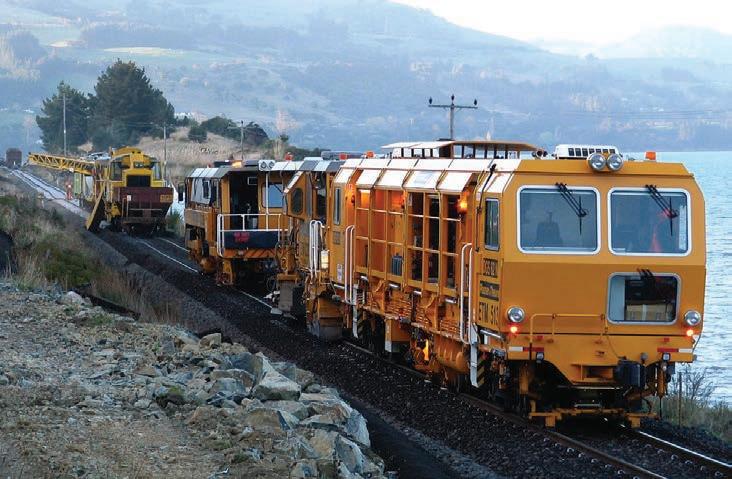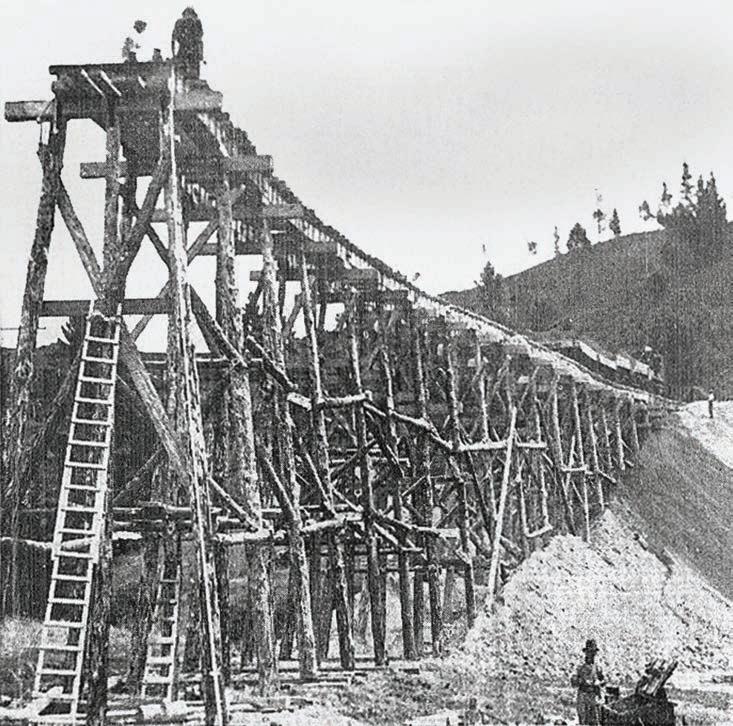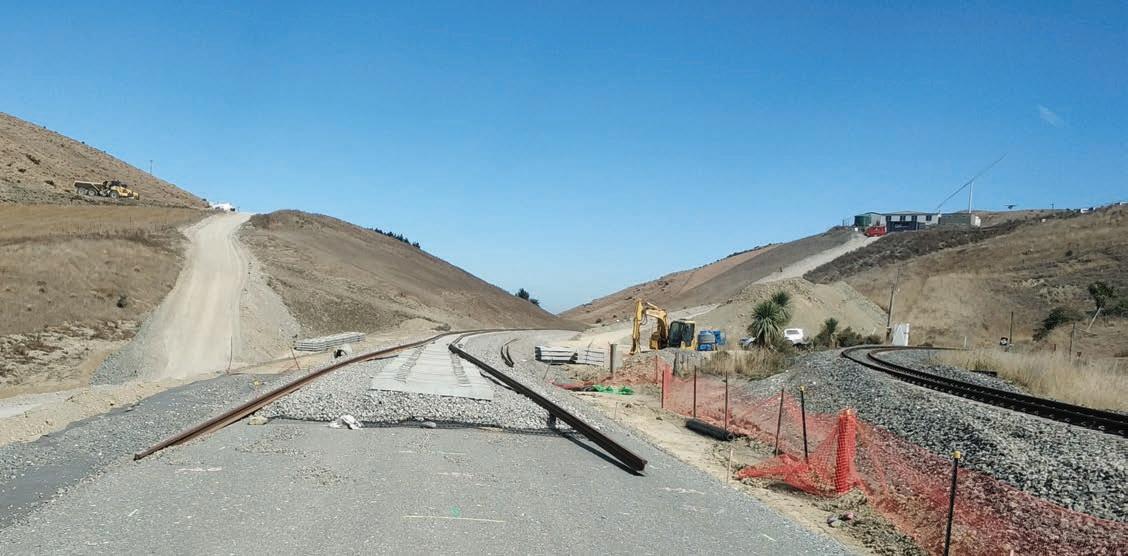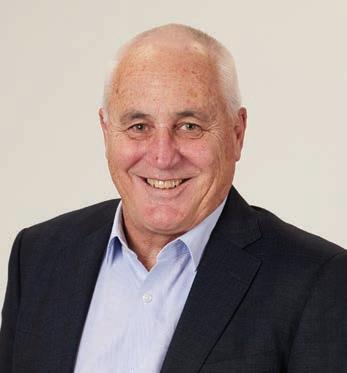
10 minute read
Auckland network rebuild
by CILTNZ
KIWIRAIL RECENTLY ANNOUNCED that major work will be required to bring the formation of the Auckland Rail Network up to scratch, ready for the workload that the City Rail Link (CRL) will impose on it, and for future growth beyond that. Logistics & Transport NZ caught up with KiwiRail’s Chief Operating Officer Capital Projects David Gordon to talk about the project, known as the Rail Network Rebuild (RNR).
The aim of the RNR is to ensure the network is up to standard, is reliable, and can safely handle the growth that is coming, explains David Gordon.
“It is a major piece of work with upgrades focused on replacing the formation - the track foundation below the rail and ballast, across 15 per cent of the 184km Auckland Metro Network. That’s the equivalent of building 26km of new rail line.”
Auckland Transport (AT) will not be able to run more frequent services without this work being done and running more frequent services is the desired outcome when the CRL is completed in the mid-2020s.
“The CRL will change the way Aucklanders commute on their rail network. The current schedule will lift to greater frequencies, enabled by a CRL that substantially increases capacity within the city centre, and across the wider network. Higher service frequency, combined with a more reliable and resilient network, means Aucklanders can have greater confidence that they can get to where they need to be using rail as public transport. And these factors will also encourage more Aucklanders out of their cars and onto electrified rail – which will help reduce Auckland’s transport emissions.
“The key priority for KiwiRail is to complete the majority of the work before CRL opens, while minimising the impact on commuters and ensuring our staff are kept safe. Doing the work after CRL opens would have introduced further delays and unreliability.”
Background to the RNR
Though there have been a number of rail improvement projects in Auckland over the last few decades - such as double tracking the Western Line, construction of the Onehunga and Manukau Lines, station rebuilds, new signaling, electrifying the network and new trains – the resulting growth in rail services in Auckland was not matched with funding for ongoing maintenance. This resulted in a reactive approach to maintenance and an increasing number of temporary speed restrictions being put on parts of the network, to ensure that services could continue to operate safely.
As well, due to the age of the Auckland network (which started being built in the 1870s) and service growth, KiwiRail has known for some time that formation on the Auckland network needed replacing at some point. Mr Gordon explains that as a general rule, 60-70 per cent of top faults (e.g., with rail or sleepers) are actually due to weaknesses in the formation, often caused by poor drainage.
In addition, construction standards have changed. What was acceptable in the 1870s suited the weight and speed of the rolling stock at the time – locomotives weighing 20-25t, on 3-4 axles (axle load under 7t) and very light wagons (only 10-12t gross on 2 axles, so the axle load was 5-6t). Even 100 years ago the largest locomotive weighed only 74t, with a maximum axle load of 14.6t. So, poorly consolidated fill and incompetent materials such as steam locomotive ash were acceptable to use. Passenger and freight traffic is many times that when parts of the network line was built, and runs at much higher speeds as well as heavier weights. Formation has to be properly designed and engineered to provide reliable and safe services.
Work of this scale, which essentially involves removing and replacing a rail line, requires significant planning, design and scheduling. “We were at the start of this planning work when tiny cracks were discovered on rail lines in Auckland, caused by rolling contact fatigue between steel train wheels and steel tracks,” Mr Gordon says. “Emergency works to replace or repair damaged rail took precedence and were carried out over an eight-month period from August 2020. This work had to be done urgently so that trains could continue running safely. “To also do the formation replacement work then would have required rail lines to be closed for longer, and we had not yet had the time to do the required planning to carry it out.”
A dynamic track stabiliser. Photo: KiwiRail
Planning for the broader renewals then resumed, with funding provided by Waka Kotahi NZ Transport Agency to meet revised costs for the project. Detailed discussions with AT about how to schedule the bulk of the RNR started in the second half of 2021.
The approach to carrying out the bulk of the RNR, including confirming the dates of the first two stages, was finalised in September 2022, and publicly announced the following Monday, 3 October. “KiwiRail and AT’s aim was to inform the public about the schedule of work as quickly as possible after it was approved and the Minister and Mayor advised. Our focus was on ensuring there was enough time before the first stage of work began, for commuters to be made aware of the upcoming disruption and plan transport alternatives.”

Why do the lines have to be closed for long periods?
“To actually do the work, the track and ballast have to be removed, and the existing formation dug out and replaced. To operate machinery safely during the work, the 25,000 volt overhead power lines have to be turned off, so electric trains cannot run, even on adjacent lines.”
To manage maintenance across an operational railway, KiwiRail generally works in short blocks of line spread over a longer timeframe. Given the scale of works required for the RNR, and with CRL completion being the key driver for delivery, Mr Gordon says a longer timeframe to carry out the work was not suitable.
“Once CRL is open there will be fewer windows available for ongoing routine maintenance. The RNR will raise the base standard of the network, allowing that standard to be maintained in the access windows available. Without being at this base standard in time for CRL, routine maintenance would not be able to keep pace with wear and tear, resulting in network performance deteriorating.
“If KiwiRail was to undertake the work in its existing Auckland maintenance windows – evenings, weekends and holiday periods – the RNR could take until 2041 to complete. This was considered unacceptable as it would mean ongoing disruption for much longer and would not allow for more frequent trains when CRL opens.”
KiwiRail and AT considered a complete network closure for a year to allow work to be carried out at numerous worksites across the Auckland Metro Network at one time. This was discounted in part due to the limited availability of labour and specialist rail equipment. “Even if more people were available, the physical constraints of the rail network with a narrow corridor and limited access points to get machinery to work sites would restrict the number of work sites that can be operating at any one time. Not to mention the impact on commuters would be far greater, given no metro rail services at all would be operating.” Mr Gordon says a staged approach was considered the most realistic.
“We looked at several approaches, including a request from AT to maintain a level of commuter service by having single line running in the peak hours which would have seen trains travelling into Britomart in the morning and vice versa in the afternoon. This was discounted as it would have significantly extended the time to complete the works beyond CRL opening and would have increased safety and operational risks. “The recommended option was to undertake the work by progressively closing segments of the network to commuter services. This option will see work in segments of the Auckland Metro Network completed prior to the opening of CRL with work on some lower patronage and outer lines taking place after CRL opens. “Closing one segment at a time impacts fewer commuters as the rest of the network remains open. It also provides incremental benefits with each reopened section of the network enabling more reliable commuter services.”
Mr Gordon says this staged approach also reduces safety and operational risks especially by being able to turn off the overhead power line and has realistic resourcing demand.
“It will improve productivity, by removing the need to repeatedly mobilise and demobilise to accommodate commuter services. Closing sections for a period of time allows us to create lay-down areas for our specialist machinery and equipment which will reduce bottlenecks and restrictions to our time schedule.
“Importantly it also allows the majority of rail freight to continue moving. Given Auckland is part of New Zealand’s busiest rail freight corridor any significant disruption to freight services would have had impacts across the national supply chain.”
KiwiRail will use a ‘design access’ approach to the work, which has shown a 300 per cent increase in productivity, when used in recent blocks of line.
Old style formation building, Swanson 1941. Photo: Papers Past (NZ Herald)

Modern engineered formation, Tar Barrel deviation, Marlborough 2021. Photo: Tonkin and Taylor
downtime, and continuously enhancing production methods and implementing new value engineering. The intent is to improve productivity as processes and methods are fine-tuned during each stage of work.
More than 130 people will be working on the RNR, about 60 per cent KiwiRail staff and 40 per cent civil and specialist contractors. KiwiRail has doubled the number of its track teams in Auckland and has secured additional plant and staff from around the country to support them.
KiwiRail will also make significant use of specialist plant to increase safety and productivity such as panel lifters to remove large sections of rail and sleepers, stabilisers to shake and consolidate formation, and tampers to align rails and pack ballast underneath.
While approximately 90 per cent of services on the Auckland Metro Network are AT’s electric multiple units (EMUs), Te Huia and the Northern Explorer will still operate as, like the freight services which will also continue to run, they are diesel-hauled and do not need the overhead power to be active. These services will be able to switch tracks to avoid worksites, and their infrequency, relative to EMU services, means any impact on work progress will be manageable.
Maintenance practices
with AT and Auckland One Rail and independently reviewed by UGL Australia. Mr Gordon explains that KiwiRail is in the process of changing its approach to maintenance delivery and capital projects. “We’re looking at every rail discipline and the systems, processes, equipment, training and work methodologies needed to support network growth and resilience. “Over the next few years the entire approach to rail maintenance in Auckland will be redesigned to allow a more proactive approach, with much more efficient planning of line closures to minimise disruption. “With the integration of CRL, automated inspection technology, early intervention maintenance regimes and greater use of specialist plant to maintain the metro lines, the aim is to significantly improve performance and productivity. This change process will take time, but we expect to have the proactive maintenance approach in place by the time CRL begins operating.”
Summary
With a number of rail projects underway ahead of CRL, Mr Gordon acknowledges this is a disruptive time for Aucklanders.
“We’re working hard to co-ordinate and optimise what we’re doing so in time we can deliver a much-improved rail network for Aucklanders.”

David Gordon
Chief Operating Officer – Capital Projects and Asset Development, oversees KiwiRail's strategic capital projects.
David joined KiwiRail in 2007 when he began working on the Wellington Regional Rail Programme as Project Director. More recently, David has held the roles of Acting Chief Executive, GGM Asset Management and Investment, and GM Network Performance. Before joining KiwiRail, he worked as a consultant in the transport infrastructure business, was Planning and Development head for Wellington International Airport and a Senior Manager in the strategy consulting team of Ernst and Young.









